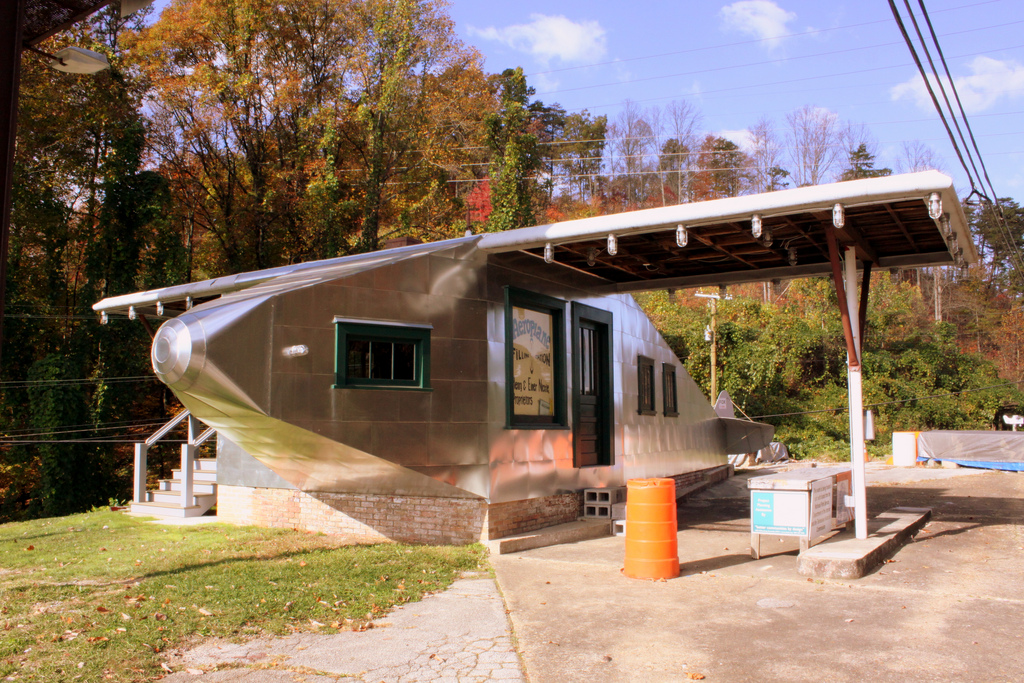Have you ever taken a trip down a long, lonely road and seen a juice stand shaped like an orange? Or a coffee house in the shape of a percolator? These types of buildings fall into a genre known as novelty architecture (also known as programmatic or mimetic architecture), a structural phenomenon that began as a uniquely American style. While the genre began in the early 1900s, some prominent examples are still visible across the country and novelty buildings are still being constructed even today.
Programmatic architecture is, simply, a style in which buildings are contracted to look like something else, usually a signifier of the business's services or products. Think of a mechanics shop with a giant car on top, or the infamous Big Duck. These fantastical structures were the result of America's booming expansion in the early 1900s, when the effects of the industrial revolution meant that city centers, the previous meccas of American merchants, were becoming increasingly crowded.
As common means of transport shifted from traveling by horse and carriage, to train, and eventually personal automobile, those with expendable income were able to travel further and further outside of the city, and the methods used by advertisers quickly changed to keep pace. Author Chester Liebs, in his book Main Street to Miracle Mile: American Roadside Architecture, refers to this as the "windshield movie", what people saw looking out of their cars as they drove the nations emerging roads. The most notable change to the landscape, inclusive of the buildings and homes springing up outside cities, "was the wholesale injection of commercials into the roadside panorama". Along the long, open roads of the developing nation, business owners saw opportunities they could not pass up. After all, car owners needed to fill up on gas, stop for food and rest, as well as for leisure activities along their routes.
Enter novelty architecture, where buildings mimic the shape of something familiar in order to draw in customers. The style initially became popular in the 1930s, and buildings of the genre were typically built along popular routes. One of the most infamous examples of novelty architecture as advertising is the original White Castle fast food restaurant, built in 1930 in Chicago (and still standing). The building was, of course, constructed to look like a white castle. Other examples of novelty architecture sprung up throughout the nation, juice bars in giant oranges, fruit stands in 15 foot high pineapples, and even company headquarters constructed to look like a giant picnic basket. By the early 1950s, almost everything the average American could need was accessible at a roadside business, with prominent advertising lining the streets.
Though novelty architecture as discussed here mostly focuses on restaurants and advertising, other prominent examples exist. The Statue of Liberty, for example, is considered novelty architecture, a functional building made to be a very recognizable symbol. The genre was not limited to the mid 1900s either, as novelty buildings are still being constructed today. Think of Las Vegas hotels and casinos, such as the Venetian, created to mimic the look of an Italian cityscape. Whether the example is a restaurant, mechanic shop, tourist booth or large hotel, the function of the novelty factor is the same.
What is your favorite "novelty" building in America? Or, if you have yet to encounter such a structure, what would your restaurant look like if housed in a novelty building? Let us know your ideas on Twitter, Facebook, Google+ or LinkedIn.
Source: Wikipedia, Main Street to Miracle Mile: American Roadside Architecture, Image Credit (Flickr)
Toggle Nav
 Tablebases.com
Tablebases.com
 Tablebases.com
Tablebases.com
Search
Toll Free

